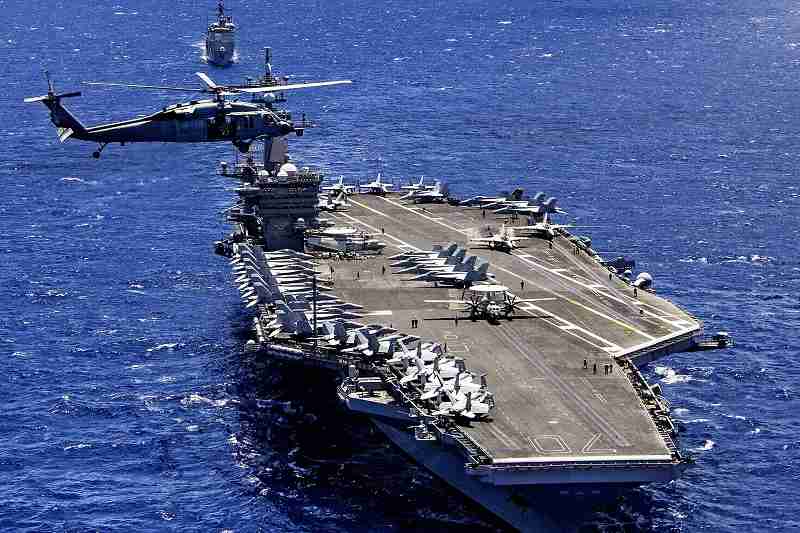
A photo provided by the U.S. Navy shows the aircraft carrier USS Carl Vinson participating in the Rim of the Pacific exercise off the coast of Hawaii in July 2018.
1:00 JST, June 27, 2022
The Rim of the Pacific (RIMPAC) exercise, a series of multinational maritime military drills hosted by the U.S. Navy, will begin on the sea off Hawaii, among other locations, on Wednesday.
Twenty-six countries, including Japan, South Korea and Australia, are scheduled to participate in RIMPAC.
The exercise will be performed with a strong awareness of the need to deter China, which is said to have larger naval capabilities in the western Pacific Ocean than the U.S. Navy.
This year, it was decided not to invite Taiwan.
In the previous RIMPAC in 2020, the whole RIMPAC exercise was scaled down due to the novel coronavirus, making this year’s exercise the first full-fledged implementation in four years.
RIMPAC is the world’s largest maritime military exercise, held every two years mainly on the sea off Hawaii.
The U.S. Navy first held RIMPAC in 1971, during the Cold War era.
For the 2022 exercise, 38 naval ships, four submarines, more than 170 aircraft and about 25,000 personnel will take part.
The Maritime Self-Defense Force has participated in every RIMPAC exercise since 1980. Russia participated in RIMPAC in 2012.
This year’s participating countries are Japan, South Korea, India, the Philippines, Indonesia, Singapore, Malaysia, Sri Lanka, Thailand, Brunei, Britain, France, Germany, Denmark, the Netherlands, Australia, New Zealand, Tonga, the United States, Canada, Mexico, Colombia, Ecuador, Chile, Peru and Israel.
The lineup of this year’s participating countries clearly reflects a sense of rivalry toward China. Included is all of the Quad — Japan, the United States, Australia and India — and AUKUS — the United States, Britain and Australia. In addition, many countries facing the South China Sea will participate.
Tonga, an island nation in the southern Pacific, where China’s influence has been growing, is also invited, giving an impression that the United States is enhancing its commitment to the region.
In 2014 and 2016, when Barack Obama was U.S. president, China also participated in the RIMPAC exercises.
The invitations aimed to encourage Beijing to comply with international rules and improve transparency through the exercise.
However, a Japan-U.S. diplomatic source said the U.S. Navy “could not conduct drills which may unveil its strategies toward China” during the exercises. Thus the drills emphasized other operations such as disaster responses.
Partly because of this, an invitation to China for the 2018 RIMPAC, when Donald Trump was U.S. president, was withdrawn on the grounds of China’s military advances in the South China Sea.
This time, it seems that the major participants will aim to integrate their most advanced capabilities, eyeing a rivalry with China.
It is predicted that the latest U.S. weaponry systems, such as unmanned boats, will be used and joint drills will be conducted for cyber and electronic warfare.
The participating countries will likely also send their largest naval vessels to RIMPAC. In addition to the U.S. sending an aircraft carrier, Japan will send the MSDF’s helicopter carrier, Izumo, and South Korea will send the Marado amphibious assault ship.
Both the U.S. House and Senate included inviting Taiwan to RIMPAC in the National Defense Authorization Act, which was passed in December last year.
It is believed the United States did not invite Taiwan to RIMPAC this time because of a desire to avoid excessive confrontation with Beijing.
Despite this, China has been on the alert. State-run China Central Television reported the opinion of a military expert who said, “They have returned to Cold War-style thinking and they are encouraging rivalries among the word powers.”
The Global Times, a Chinese newspaper, reported that Beijing assumes this year’s RIMPAC will be the largest ever. It seems that Beijing is uneasy about improvements in participating countries’ joint operational capabilities.
The English version of the newspaper reported that the MSDF will among other things send Izumo to RIMPAC, and insisted that Japan has “violated the pacifist constitution.”
During the 2018 RIMPAC exercise, China deployed vessels to gather information off Hawaii. In 2020, China conducted a series of military drills in four maritime areas in its own vicinity.
It is assumed that China will conduct drills or dispatch information-gathering vessels this time as well to show its opposition.
"Politics" POPULAR ARTICLE
-

Japan to Support Central Asian Logistics Route That Bypasses Russia, Plan to Be Part of Upcoming Summit in Tokyo
-

Japan to Tighten Screening of Foreigners’ Residential Status by Providing Information of Nonpayment of Taxes
-

Chinese, Russian Bombers Flew Unusual Path by Heading Toward Tokyo; Move Likely Meant to Intimidate Japan
-

Japan Plans National Database to Track Foreign Ownership of Real Estate, Land as It Weighs New Rules
-

Up to 199,000 Deaths Estimated From Mega-Tsunami; Most Recent Occurrence Took Place in 17th Century
JN ACCESS RANKING
-

Tokyo Economic Security Forum to Hold Inaugural Meeting Amid Tense Global Environment
-

Keidanren Chairman Yoshinobu Tsutsui Visits Kashiwazaki-Kariwa Nuclear Power Plant; Inspects New Emergency Safety System
-

Imports of Rare Earths from China Facing Delays, May Be Caused by Deterioration of Japan-China Relations
-

University of Tokyo Professor Discusses Japanese Economic Security in Interview Ahead of Forum
-

Japan Pulls out of Vietnam Nuclear Project, Complicating Hanoi’s Power Plans
























